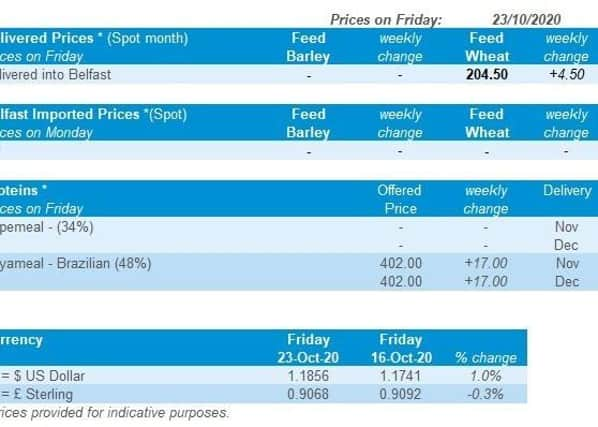Northern Ireland Weekly Market Report


26 October 2020
Grains
Wheat - Increased import demand means global supplies are less comfortable than on paper. Earlier than usual concerns over 2021 Northern Hemisphere wheat crops continue to drive market sentiment.
Maize - Continued strong import demand by China is driving the short term outlook for prices. Longer-term the outlook will partly depend on South American production, so conditions here need to be monitored.
Advertisement
Advertisement
Barley - The potential for barley prices to gain continues to depend on other grains, because of heavy global supplies. UK barley balance again looks heavy and the pace of exports will be important.
Global markets - Global grain markets continued to rally last week because of continued import demand by China and worries about planting conditions in the Black Sea, South America and Unites States. These worries, along with speculative traders continuing to buy into futures markets, continue to drive global grain prices higher.
The planting and early development of wheat crops for the 2021/22 season in the Black Sea and United States is being hampered by dry weather. Some rainfall is expected in parts of Russia in the next week, which may alleviate some of the dryness concerns.
The Argentine wheat crop was cut by a further 0.7Mt last week (Buenos Aries Grain Exchange) to 16.8Mt because of dry conditions. In Brazil, delays planting soyabeans due to dry conditions will likely delay planting of the following (safrinha) maize crop in early 2021. Delays to planting safrinha maize mean there’s a greater chance of hot or dry weather when these crops pass through their key growth stages, which could limit yield potential.
Advertisement
Advertisement
China continues to buy US maize, despite the country having imported or booked enough to fill both its 2020 and 2021 low tariff quotas (7.2Mt each). However, there is growing speculation that China will increase the quota, which would support continued high import demand and so prices. Demand for wheat by other major importers, including Egypt, is also supporting prices.
UK focus
The balance between UK supply and demand is estimated at 1.08Mt, in AHDB’s 2020/21 early balance sheets, the tightest in decades. The main reason is the arguably unprecedented year on year drop in wheat production. Imports are forecast at 2.15Mt, more than double 2019/20 level, while demand is lower from the bioethanol, starch, distilling and animal feed sectors. A balance of this size poses challenges to both the industry and forecasting, putting the UK market on a knife edge in 2020/21.
In contrast, exports will once again be key for UK barley stocks. Barley’s large price discount to wheat means that animal feed demand is forecast nearly 0.6Mt above last season’s record level. However, it’s not enough on its own because of the higher opening stocks, very large crop and reduced demand from the human and industrial sectors.
The first official UK supply and demand estimate is provisionally scheduled to be published on 26 November, which will give estimates for all cereals.
Oilseeds
Advertisement
Advertisement
Rapeseed - Despite pressure on crude oil there is still support within the oilseed complex. OSR is tracking the soyabean market gains.
Soyabeans - Chinese purchasing of soyabeans continues to support prices, driving the entire oilseed complex. Dry weather in South America is becoming a close watch point as planting is ongoing. Precipitation forecast this week across the Goiás and parts of Mato Grosso region could temper gains.
Global markets - There was support across the week for the oilseed complex, largely driven by soyabeans. The Chicago soyabeans futures contract (Nov-20) closed Friday at $398.17/t, gaining $12.40/t across the week.
Predominantly driving this increase is Chinese purchasing, with September imports up 19% year-on-year at 9.8Mt. In recent months, large purchases of US origin soyabeans have supported prices as China fulfils its phase 1 trade deal commitment.
Advertisement
Advertisement
Pockets of dry weather in Brazil as planting is underway is providing another bullish factor, with the lack of moisture not helping germination of newly planted crops.
Malaysian palm oil futures (third delivery month) gained 2.51% across the week, tracking the support seen in other oil markets. Exports of Malaysian palm oil products rose by 7.2% in October (up to the 25th) to 1.4Mt, increasing from 1.3Mt in the first 25 days of September, according to cargo surveyor Intertek testing services.
Increased Covid-19 infections in the US and Europe has raised alarms over the demand for crude oil. The potential increase in output from the OPEC group of countries by 2 million barrels a day in January 2021 is causing further pressure.
For the oilseed complex, strong demand overshadowed the 2.7% decrease in Brent crude oil (nearby) last week.
Rapeseed focus
Advertisement
Advertisement
Paris rapeseed futures (Nov-20) closed Friday at €392.00/t, gaining €2.00/t across the week. The contract closed at a high of €395.00/t in the middle of the week; it finishes trading this Friday.
ICE canola futures (Nov-20) gained CA$23.00/t across the week, to close Friday at CA$550.00/t. Support has been from a mix of fund-driven buying, commercial short coverings and a lack of farmer selling.
UK delivered rapeseed (into Liverpool) was quoted at £362.00/t, gaining £2.50/t across the week. There was a degree of volatility between sterling and the euro during the week, as the Brexit deadline looms. Sterling weakened over the week by 0.26%, to close Friday at £1 = €1.099.